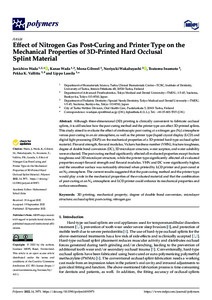Effect of Nitrogen Gas Post-Curing and Printer Type on the Mechanical Properties of 3D-Printed Hard Occlusal Splint Material
Wada Junichiro; Vallittu Pekka K; Iwamoto Tsutomu; Wakabayashi Noriyuki; Lassila Lippo; Gibreel Mona; Wada Kanae
Effect of Nitrogen Gas Post-Curing and Printer Type on the Mechanical Properties of 3D-Printed Hard Occlusal Splint Material
Wada Junichiro
Vallittu Pekka K
Iwamoto Tsutomu
Wakabayashi Noriyuki
Lassila Lippo
Gibreel Mona
Wada Kanae
MDPI
Julkaisun pysyvä osoite on:
https://urn.fi/URN:NBN:fi-fe2022112967857
https://urn.fi/URN:NBN:fi-fe2022112967857
Tiivistelmä
Although three-dimensional (3D) printing is clinically convenient to fabricate occlusal splints, it is still unclear how the post-curing method and the printer type can affect 3D-printed splints. This study aimed to evaluate the effect of stroboscopic post-curing at a nitrogen gas (N-2) atmosphere versus post-curing in an air atmosphere, as well as the printer type (liquid crystal display (LCD) and digital light processing (DLP)) on the mechanical properties of a 3D-printed hard-type occlusal splint material. Flexural strength, flexural modulus, Vickers hardness number (VHN), fracture toughness, degree of double bond conversion (DC), 3D microlayer structure, water sorption, and water solubility were evaluated. The post-curing method significantly affected all evaluated properties except fracture toughness and 3D microlayer structure, while the printer type significantly affected all evaluated properties except flexural strength and flexural modulus. VHN and DC were significantly higher, and the smoother surface was noticeably obtained when printed by LCD printer and post-cured at an N-2 atmosphere. The current results suggested that the post-curing method and the printer type would play a role in the mechanical properties of the evaluated material and that the combination of post-curing at an N-2 atmosphere and LCD printer could enhance its mechanical properties and surface smoothness.
Kokoelmat
- Rinnakkaistallenteet [19207]
